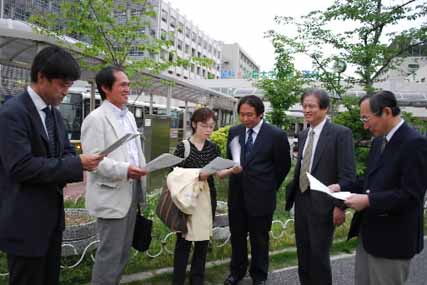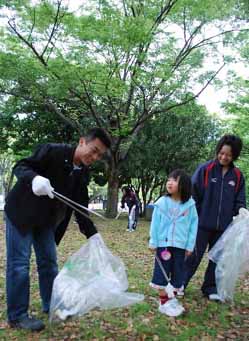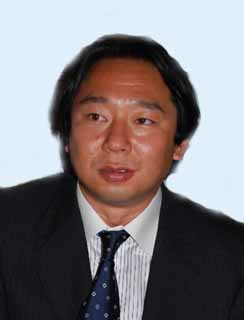Fostering Hiroshima’s peace activities
May 28, 2008
by Miho Kuwajima, by Staff Writer
After experiencing unprecedented destruction in the atomic bombing, Hiroshima rose from the ashes. The city was rebuilt through the untiring efforts of its citizens as well as various forms of aid from within Japan and from abroad. “That’s why many people in Hiroshima feel international aid is an issue of concern to them,” says Kensuke Onishi, Director of Peace Winds Japan, an NPO based in Tokyo. New activities are getting underway at the grass roots level in Hiroshima, primarily under the direction of non-governmental agencies. These include international aid and other programs that have lowered their barriers in order to encourage more people to participate. These programs are active on a global level as well as in Hiroshima. This report looks at groups that are taking on new challenges and working to overcome them.
Doctors explore possibility of forming base for providing overseas aid
On the evening of May 8, 2008, Mayumi Fujimoto, 45, a physician in Hiroshima, asked Mitsuo Ochi, Director of Hiroshima University Hospital, to cooperate in an effort to dispatch doctors to Cambodia to provide medical support. Dr. Fujimoto called on Dr. Ochi along with five dentists and university professors in Hiroshima who are members of Peace Contribution NGOs Hiroshima, a non-profit organization.
They hope to form a local group to provide reconstruction assistance following conflicts and natural disasters. They plan to include quick responses to emergencies similar to the efforts of the Association of Medical Doctors of Asia (AMDA), an international medical volunteer organization based in Okayama.
Dr. Ochi told the group he would seriously consider their request and that he would also consider providing an experienced doctor. Afterwards Dr. Fujimoto said she felt some progress had been made.
Before becoming a member of Peace Contribution NGOs Hiroshima, which was established in 2004 under the aegis of the Hiroshima prefectural government, Dr. Fujimoto went to Cambodia five times at the government’s request.
In Cambodia, she was primarily in charge of organizing a program to give medical examinations to elementary school students and to check their height and weight. The project began with an effort to convey the purpose of medical examinations, but as she realized the limits of government-led “peace contributions,” Dr. Fujimoto came to feel, through each subsequent visit to Cambodia, that she wanted to pursue this work beyond the governmental channel.
“The person in charge of the project for the prefecture was always changing,” Dr. Fujimoto said, “but the biggest problem was that aid projects are limited to only three years. Hiroshima needs an organization that can provide reconstruction assistance over a long period of time.” She said she also sensed that aid representing Hiroshima is welcomed by the recipients.
Dr. Fujimoto became a member of the group and urged others to join her in creating a network of doctors in Hiroshima. The visit to Hiroshima University Hospital was the first step in this effort.
Kazumi Mizumoto, 51, an associate professor at the Hiroshima Peace Institute, was one of those who went to the hospital with Dr. Fujimoto. He explained the significance of creating an organization based in Hiroshima, whose name is known throughout the world.
“Hiroshima has a lot of experience, such as in providing mental health care for the A-bomb survivors and its peace education activities, that can be put to use in building a peaceful society abroad. When we tell people overseas we’re from Japan, it tends to conjure up images of the Japan-U.S. alliance or monetary donations, but when we say we’re offering aid from Hiroshima, it is willingly accepted.”
During the Vietnam War a group in Hiroshima Prefecture brought young people who were seriously injured due to the conflict, such as by landmines, here for treatment, and there are other organizations that continue to provide medical support to certain countries at the grass-roots level. The government and major medical institutions cooperated to establish the Hiroshima International Council for Health Care of the Radiation-exposed (HICARE), which has provided medical care for radiation-exposed people overseas for the past 17 years. This background in Hiroshima supports the activities of Dr. Fujimoto and the other members of her group.
Young and old conduct clean-up of A-bomb hypocenter
The clean-up of Peace Memorial Park by a non-profit organization is broadening its scope. This small effort to clean up the park, a symbol of Hiroshima that is visited by people from Japan and around the world, is offering young people an opportunity to take their first step toward getting involved in peace-related activities.
On the morning of Sunday, May 11, after the rain had let up, about 50 people dressed in comfortable clothes and ranging in age from kindergarteners to those in their 70s, gathered in twos and threes at the foot of the Motoyasu Bridge on the east side of the park. They pick up trash in the park once a month in response to a request by the HPS International Volunteers. Their group includes members of a company women’s hockey team.
“After the bombing, the people of Hiroshima devoted their lives to rebuilding the city. Banks, transport companies, everyone had a sense of mission to get the city back on its feet,” said Hiroe Sato, 69, the group’s leader. Every month for 5 minutes before they begin picking up trash, Sato tells the volunteers about her A-bomb experience and talks about the lives of Hiroshima citizens during the rebuilding of the city.
“The souls of more than 250,000 people, including those who died after the war, repose in the A-bomb cenotaph,” Sato said. “By cleaning up the park themselves, I would like the volunteers to think about those who came before us who struggled to live from day-to-day.”
Most of those who participated in the clean-up said they had come upon the organization’s website while searching the Internet for information on environmental activities. Mai Ichikawa, 19, a sophomore at Yasuda Women’s College, said she had been changed by the experience. “I’m interested in volunteering in environmental activities, so I participated along with a friend. Hearing Ms. Sato’s speech, I’ve been confronted with the issue of peace and the A-bomb experience as well,” she said.
Living in Hiroshima you often hear that it’s always the same people who participate in peace-related activities and that it’s difficult to get new people involved, but steady progress is being made. Hiroshima’s peace activities are growing and diversifying.
Interview with Kensuke Onishi, 40, director of Peace Winds Japan
“There are two kinds of international volunteer support: grass roots and organizational. Over the years many support groups have been organized at the individual level in Hiroshima, but there is no organization that has continued to serve as a base for providing reconstruction assistance and support following disasters overseas.
In neighboring Okayama Prefecture the Association of Medical Doctors of Asia (AMDA), an international volunteer organization, has provided medical support to developing countries since 1984. They offered support immediately following the recent natural disasters in Myanmar and China.
Considering the size of Hiroshima, there’s no reason a similar organization couldn’t be formed here. Many people feel international aid is an issue of concern to them as a result of peace education based on the city’s experience with the atomic bomb.
The efforts of Dr. Fujimoto and the other doctors from Hiroshima to form a local medical support organization is a big step forward.
According to AMDA’s statement of income and expenditures, donations amounted to ¥180 million in fiscal 2006. The key to forming a similar organization based in Hiroshima is how far businesses and other members of the local community are willing to cooperate in the effort.”
After experiencing unprecedented destruction in the atomic bombing, Hiroshima rose from the ashes. The city was rebuilt through the untiring efforts of its citizens as well as various forms of aid from within Japan and from abroad. “That’s why many people in Hiroshima feel international aid is an issue of concern to them,” says Kensuke Onishi, Director of Peace Winds Japan, an NPO based in Tokyo. New activities are getting underway at the grass roots level in Hiroshima, primarily under the direction of non-governmental agencies. These include international aid and other programs that have lowered their barriers in order to encourage more people to participate. These programs are active on a global level as well as in Hiroshima. This report looks at groups that are taking on new challenges and working to overcome them.
Doctors explore possibility of forming base for providing overseas aid
On the evening of May 8, 2008, Mayumi Fujimoto, 45, a physician in Hiroshima, asked Mitsuo Ochi, Director of Hiroshima University Hospital, to cooperate in an effort to dispatch doctors to Cambodia to provide medical support. Dr. Fujimoto called on Dr. Ochi along with five dentists and university professors in Hiroshima who are members of Peace Contribution NGOs Hiroshima, a non-profit organization.
They hope to form a local group to provide reconstruction assistance following conflicts and natural disasters. They plan to include quick responses to emergencies similar to the efforts of the Association of Medical Doctors of Asia (AMDA), an international medical volunteer organization based in Okayama.
Dr. Ochi told the group he would seriously consider their request and that he would also consider providing an experienced doctor. Afterwards Dr. Fujimoto said she felt some progress had been made.
Before becoming a member of Peace Contribution NGOs Hiroshima, which was established in 2004 under the aegis of the Hiroshima prefectural government, Dr. Fujimoto went to Cambodia five times at the government’s request.
In Cambodia, she was primarily in charge of organizing a program to give medical examinations to elementary school students and to check their height and weight. The project began with an effort to convey the purpose of medical examinations, but as she realized the limits of government-led “peace contributions,” Dr. Fujimoto came to feel, through each subsequent visit to Cambodia, that she wanted to pursue this work beyond the governmental channel.
“The person in charge of the project for the prefecture was always changing,” Dr. Fujimoto said, “but the biggest problem was that aid projects are limited to only three years. Hiroshima needs an organization that can provide reconstruction assistance over a long period of time.” She said she also sensed that aid representing Hiroshima is welcomed by the recipients.
Dr. Fujimoto became a member of the group and urged others to join her in creating a network of doctors in Hiroshima. The visit to Hiroshima University Hospital was the first step in this effort.
Kazumi Mizumoto, 51, an associate professor at the Hiroshima Peace Institute, was one of those who went to the hospital with Dr. Fujimoto. He explained the significance of creating an organization based in Hiroshima, whose name is known throughout the world.
“Hiroshima has a lot of experience, such as in providing mental health care for the A-bomb survivors and its peace education activities, that can be put to use in building a peaceful society abroad. When we tell people overseas we’re from Japan, it tends to conjure up images of the Japan-U.S. alliance or monetary donations, but when we say we’re offering aid from Hiroshima, it is willingly accepted.”
During the Vietnam War a group in Hiroshima Prefecture brought young people who were seriously injured due to the conflict, such as by landmines, here for treatment, and there are other organizations that continue to provide medical support to certain countries at the grass-roots level. The government and major medical institutions cooperated to establish the Hiroshima International Council for Health Care of the Radiation-exposed (HICARE), which has provided medical care for radiation-exposed people overseas for the past 17 years. This background in Hiroshima supports the activities of Dr. Fujimoto and the other members of her group.
Young and old conduct clean-up of A-bomb hypocenter
The clean-up of Peace Memorial Park by a non-profit organization is broadening its scope. This small effort to clean up the park, a symbol of Hiroshima that is visited by people from Japan and around the world, is offering young people an opportunity to take their first step toward getting involved in peace-related activities.
On the morning of Sunday, May 11, after the rain had let up, about 50 people dressed in comfortable clothes and ranging in age from kindergarteners to those in their 70s, gathered in twos and threes at the foot of the Motoyasu Bridge on the east side of the park. They pick up trash in the park once a month in response to a request by the HPS International Volunteers. Their group includes members of a company women’s hockey team.
“After the bombing, the people of Hiroshima devoted their lives to rebuilding the city. Banks, transport companies, everyone had a sense of mission to get the city back on its feet,” said Hiroe Sato, 69, the group’s leader. Every month for 5 minutes before they begin picking up trash, Sato tells the volunteers about her A-bomb experience and talks about the lives of Hiroshima citizens during the rebuilding of the city.
“The souls of more than 250,000 people, including those who died after the war, repose in the A-bomb cenotaph,” Sato said. “By cleaning up the park themselves, I would like the volunteers to think about those who came before us who struggled to live from day-to-day.”
Most of those who participated in the clean-up said they had come upon the organization’s website while searching the Internet for information on environmental activities. Mai Ichikawa, 19, a sophomore at Yasuda Women’s College, said she had been changed by the experience. “I’m interested in volunteering in environmental activities, so I participated along with a friend. Hearing Ms. Sato’s speech, I’ve been confronted with the issue of peace and the A-bomb experience as well,” she said.
Living in Hiroshima you often hear that it’s always the same people who participate in peace-related activities and that it’s difficult to get new people involved, but steady progress is being made. Hiroshima’s peace activities are growing and diversifying.
Interview with Kensuke Onishi, 40, director of Peace Winds Japan
“There are two kinds of international volunteer support: grass roots and organizational. Over the years many support groups have been organized at the individual level in Hiroshima, but there is no organization that has continued to serve as a base for providing reconstruction assistance and support following disasters overseas.
In neighboring Okayama Prefecture the Association of Medical Doctors of Asia (AMDA), an international volunteer organization, has provided medical support to developing countries since 1984. They offered support immediately following the recent natural disasters in Myanmar and China.
Considering the size of Hiroshima, there’s no reason a similar organization couldn’t be formed here. Many people feel international aid is an issue of concern to them as a result of peace education based on the city’s experience with the atomic bomb.
The efforts of Dr. Fujimoto and the other doctors from Hiroshima to form a local medical support organization is a big step forward.
According to AMDA’s statement of income and expenditures, donations amounted to ¥180 million in fiscal 2006. The key to forming a similar organization based in Hiroshima is how far businesses and other members of the local community are willing to cooperate in the effort.”









